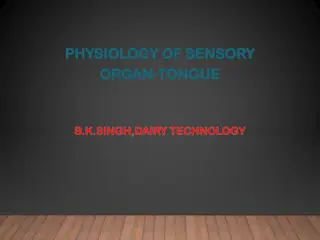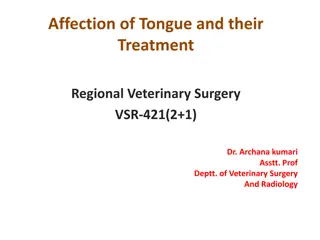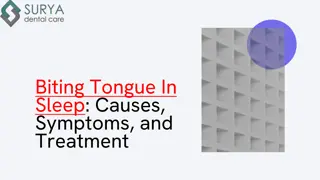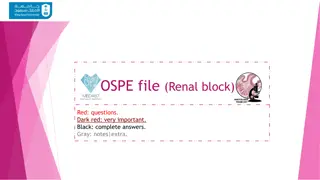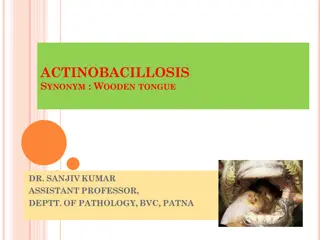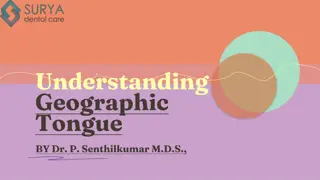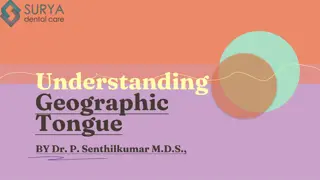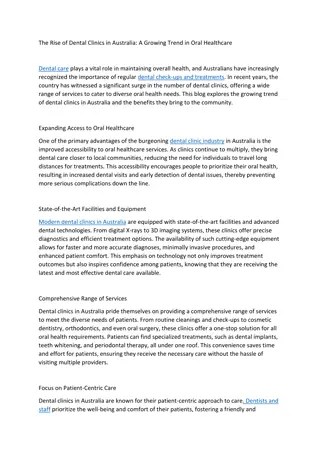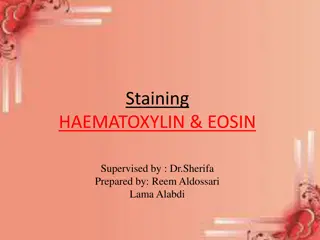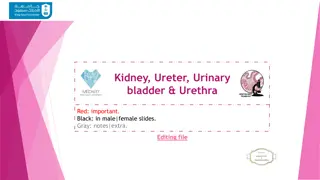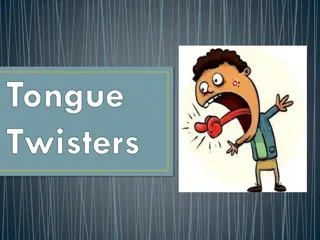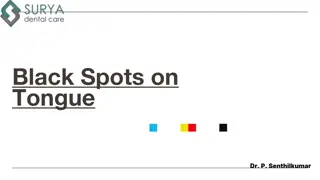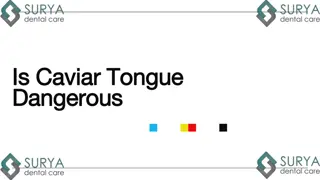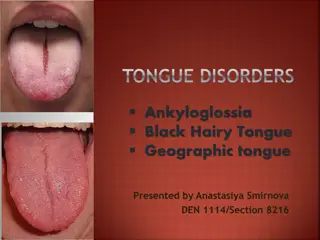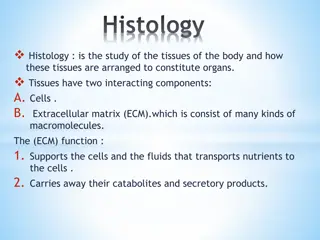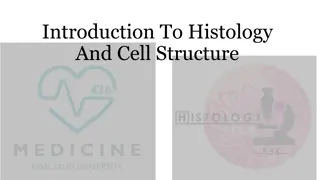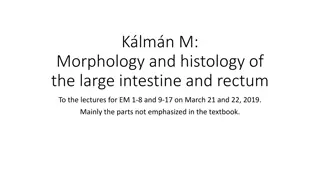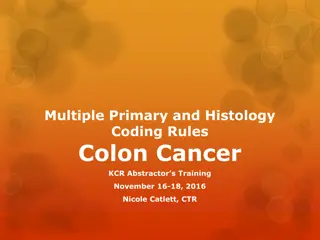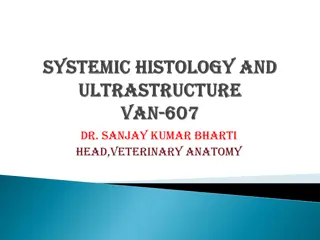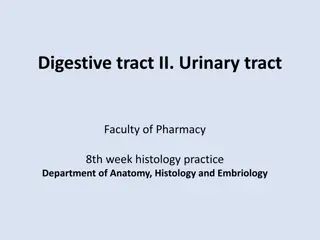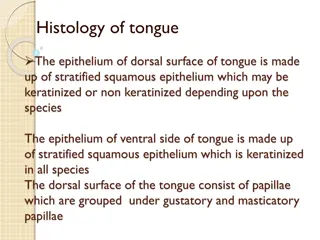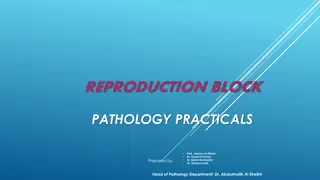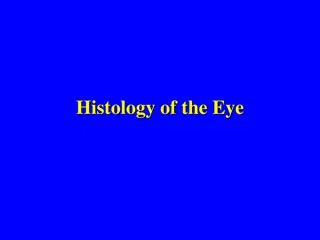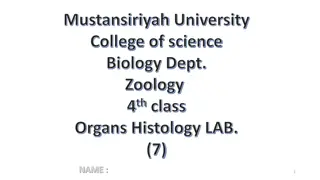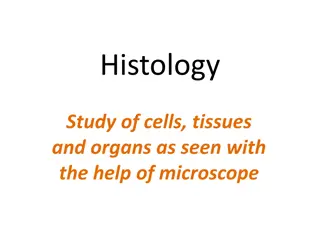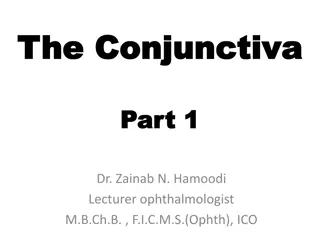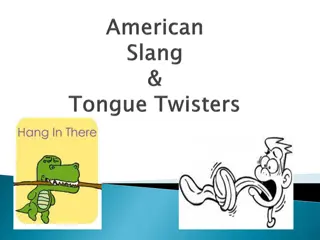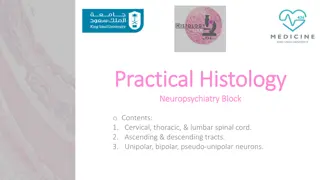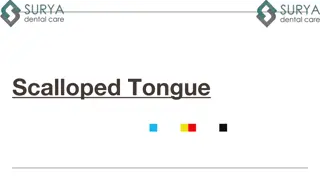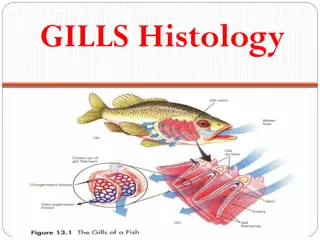Durga Mahavidyalaya
Education is viewed as the acquisition of knowledge, skills, beliefs, and moral habits. Mahatma Gandhi introduced his Basic Education concept emphasizing free and compulsory education, mother tongue instruction, craft-centered learning, moral education, and character building. The curriculum include
0 views • 6 slides
Understanding the Physiology of the Sensory Organ - Tongue by B.K. Singh
Taste perception on the tongue is a vital sensory function involving sweet, sour, salty, and bitter sensations. The tongue, with its muscular movements and taste buds, plays a crucial role in mastication, swallowing, and food enjoyment. Different types of papillae on the tongue are responsible for t
4 views • 33 slides
Treatment of Tongue Affections in Veterinary Surgery by Dr. Archana Kumari
In this educational material, Dr. Archana Kumari discusses various tongue affections in animals such as strangulation, smooth tongue, tumors, and ranula. Treatment methods for each condition are described in detail, providing valuable insights for veterinary surgeons. From managing venous engorgemen
0 views • 21 slides
Renal Block Pathology Practical: Anatomy and Histology Overview
The Renal Block Pathology Practical provides a comprehensive insight into the anatomy, structure, and histology of the kidney nephrons, including normal and abnormal conditions such as acute kidney injury. The session covers topics like the structure of the nephron, normal kidney gross anatomy, rena
3 views • 47 slides
Understanding the Intrinsic Muscles of the Tongue - Anatomy and Physiology Overview
In this detailed presentation by Dr. Sushma Tomar, Associate Professor of Anatomy, the intrinsic muscles of the tongue are explored, along with their functions, arterial and venous supply, lymphatic drainage, and nerve supply. The lecture covers the four intrinsic muscles in each half of the tongue,
1 views • 15 slides
Biting Tongue In Sleep - Causes, Symptoms, and Treatment
See a dentist if you discover that you are clenching your teeth throughout the day or biting your tongue when you are sleeping. If tongue bites continue to cause considerable bleeding, there might be a more serious problem. A dentist can determine th
3 views • 10 slides
Histology of the Renal System for OSPE Exam Preparation
This comprehensive OSPE file for renal block covers key structures of the kidney including the cortex, juxtaglomerular apparatus, renal corpuscle, and kidney medulla. It provides detailed identification of structures, labeling of components, and differentiation between tubules. Helpful images and de
0 views • 11 slides
Actinobacillosis (Wooden Tongue) in Cattle and Sheep: Overview of the Infectious Disease
Actinobacillosis, also known as Wooden Tongue, is a specific infectious disease affecting cattle and sheep, caused by Actinobacillus lignieresii. It is characterized by fibrosis of the tongue and soft tissues, leading to mobility issues. The disease is primarily transmitted through wounds and abrasi
0 views • 8 slides
what is Geographic Tongue and how does it look
Geographical tongue is an non-contagious condition that provides an atypical, map-like structure to the tongue. A detailed note on this problem is given here. For More Info Visit: \/\/ \/what-is-geographic-tongue\/
0 views • 11 slides
what is Geographic Tongue and how does it look
Geographical tongue is an non-contagious condition that provides an atypical, map-like structure to the tongue. A detailed note on this problem is given here. For More Info Visit: \/\/ \/what-is-geographic-tongue\/
0 views • 11 slides
Frenectomy, Tongue Tie Melbourne | Rosanna Family Dental Clinic
Frenectomy is simple surgical procedure to remove the frenum tissues or tongue, also known as Tongue tie treatment. To know more, call Rosanna Family Dental Clinic in Melbourne on (03) 94591194.\n\n
0 views • 2 slides
Understanding H&E Staining in Histology
H&E staining, a widely used histological technique, involves staining cell nuclei blue and cytoplasmic components pink to aid in tissue structure analysis. This method provides essential insights into normal and pathological tissue changes, assisting in diagnoses and further testing decisions. The p
0 views • 7 slides
Microscopic Structure and Histology of Kidney and Urinary Tract
Explore the intricate details of kidney anatomy, nephron structure, glomerular filtration barrier, and the histology of renal cortex and medulla, renal corpuscle, proximal and distal tubules, juxtaglomerular apparatus, as well as the urinary bladder and urethra in both male and female. Delve into th
0 views • 17 slides
Fun Tongue Twisters for a Twist of Laughter
Enjoy a collection of amusing tongue twisters that will twist your tongue and tickle your funny bone! From throwing balls to selling sea shells, these tongue twisters will challenge your pronunciation skills. Repeat them multiple times for a hilarious tongue workout. Additionally, experience whimsic
0 views • 12 slides
Black Spots on Tongue - Surya Dental Care
Black spots on the tongue can go away if you maintain proper oral hygiene, and in some cases, they may last longer, which indicates severe conditions like tongue cancer. For more info visit: \/\/ \/what-causes-black-spots-on-tongue\/
1 views • 10 slides
Introduction to Histology and Microscopy in Anatomy
Histology is the study of tissue structure and function in animals and plants, focusing on the microscopic structure of cells, tissues, and organs. It helps in understanding the relationship between structure and function, intertwining disciplines like cell biology, pathology, physiology, and bioche
0 views • 5 slides
Is Caviar Tongue Dangerous
Caviar tongue is an unharmful condition, appearing as a black hairy tongue on the undersurface of the tongue, which is caused by the aging factor in most individuals.
0 views • 10 slides
NGM282 in NASH: Phase 2 Study on Liver Fat Reduction and Histology Changes
A phase 2 study on NGM282 in NASH patients showed a significant decrease in liver fat content, meeting the primary endpoint. Exploratory findings also indicated potential improvements in liver histology. The treatment involved NGM282 at 3 mg QD, with additional rosuvastatin if needed. Promising resu
0 views • 11 slides
Understanding Tongue Disorders: Ankyloglossia, Black Hairy Tongue, Geographic Tongue
Ankyloglossia, also known as tongue-tied, is a congenital anomaly affecting tongue mobility. Black hairy tongue is the lengthening of papillae on the tongue surface, often temporary and resolve without treatment. Geographic tongue presents as white patches and is usually asymptomatic. Treatment opti
0 views • 10 slides
Overview of Histology: Study of Tissues and Organs
Histology involves studying the tissues of the body and how they form organs. Tissues consist of cells and extracellular matrix, with functions like support, nutrient transport, and waste removal. The human body comprises epithelial, connective, muscular, and nervous tissues, each with specific func
0 views • 4 slides
Introduction to Histology and Cell Structure
Histology is the microscopic study of normal tissues utilizing light and electron microscopes. This field explores the composition and function of cells, focusing on the nucleus, cytoplasm, organelles, and inclusions. Thin tissue sections stained with Haematoxylin and Eosin reveal distinct cellular
0 views • 23 slides
Understanding Histology and Cell Structure Fundamentals
Delve into the intriguing world of histology and cell structure, exploring the composition of cells, the functions of various components like the nucleus and cytoplasm, and the significance of organelles. Discover how histology is studied, the types of microscopes used, and the vital role of the cel
0 views • 24 slides
Challenges Faced in Histology Workforce Recruitment and Retention
Shelly Semerad, MA, CT (ASCP), faced challenges in recruiting and retaining histology personnel, leading to overnight positions remaining unfilled for months. Despite standard recruitment efforts and revised offerings, the shortage persisted. The team learned the importance of competitive compensati
0 views • 7 slides
Understanding Epithelial Tissue in General Histology
Epithelial tissue is a crucial type of tissue in the human body, performing functions like protection, absorption, secretion, and sensation detection. This tissue is composed of cells with minimal extracellular matrix and plays a vital role in various bodily processes. Learn about the classification
0 views • 47 slides
Anatomy Review: Large Intestine and Rectum Histology
The presentation delves into the detailed morphology and histology of the large intestine and rectum, covering aspects often not emphasized in textbooks. It explores nuances such as the S-shaped structure of the rectum, the composition of the anal canal, the layers of epithelium, and the territorial
1 views • 8 slides
Guidelines for Multiple Primary & Histology Coding in Colon Cancer Abstractor Training
Utilize the Multiple Primary & Histology Coding Rules for accurate case abstraction. Understand equivalent terms, definitions, and instructions to determine multiple primaries for solid malignant tumors diagnosed after January 1, 2007. Avoid relying on physician statements and prioritize following t
0 views • 64 slides
Anatomy of the Tongue: A Detailed Exploration
Squamous epithelium, striated muscle, and various types of papillae make up the intricate structure of the tongue. Filliform, fungiform, circumvallate, and foliate papillae play different roles in sensory perception and taste. Taste buds, Van Ebner's glands, and gustatory furrows add complexity to t
0 views • 40 slides
Histology Overview of Digestive and Urinary Tracts in Pharmacy Practice
This histology practice session delves into the intricate details of the digestive and urinary tracts studied in the 8th week of Pharmacy school. Explore images showcasing the structures of the colon, vermiform appendix, liver, pancreas, and nephron. Gain insights into the histological features of t
0 views • 19 slides
Leading Pathology and Histology Laboratory in Israel
L.E.M Laboratory in Israel, founded in 2001, is a premier facility offering high-quality medical services including Pathology and Histology tests. The lab stands out for its commitment to technology in the field, advanced information systems for efficient management, and stringent quality control me
0 views • 14 slides
Histology of the Tongue: Structure and Function Overview
The tongue is covered by stratified squamous epithelium with various types of papillae on its dorsal surface, each serving specific functions such as taste perception and mechanical tasks. The filiform, fungiform, vallate, foliate, and circumvallate papillae are distinct in their appearance and dist
0 views • 10 slides
Male Reproductive System: Testis and Prostate Anatomy and Histology
Explore the normal anatomy and histology of the testis and prostate in the male reproductive system. Detailed images and descriptions provide insights into the structures and functions of these important organs. Understand the gross and microscopic features of the testis, including seminiferous tubu
0 views • 39 slides
Histology of the Eye: Structure and Function Overview
Explore the histology of the eye, covering the general structure and the microscopic details of the cornea and retina. Learn about the three coats of the eye bulb, including the fibrous, vascular, and neural tunics. Dive into the composition of the cornea, from its transparent and highly innervated
0 views • 24 slides
Anatomy and Histology of the Eye: A Comprehensive Study
An in-depth exploration of the anatomy and histology of the eye, covering structures such as the cornea, sclera, choroid, iris, and more. Detailed descriptions of each component, including layers, composition, and functions, are provided alongside accompanying images for visual reference.
0 views • 11 slides
Introduction to Histology: Study of Cells, Tissues, and Organs
Histology, also known as microscopic anatomy, focuses on the study of cells, tissues, and organs through a microscope. It encompasses the examination of epithelial tissues, their special characteristics, functions, and embryological origins. Epithelial tissues play crucial roles in protection, absor
0 views • 55 slides
Understanding the Anatomy and Histology of the Conjunctiva
This educational content explores the intricate details of the conjunctiva, a thin mucous membrane that lines the inner surface of the eyelids and globe. Topics include anatomical divisions, histological features such as epithelium and stroma, and common microbial conjunctival pathologies like bacte
0 views • 51 slides
Understanding Slang, Idioms, and Tongue Twisters
Explore the world of slang, idioms, and tongue twisters to better understand informal language expressions. From slang used by specific groups to popular idioms recognized by the public, delve into the nuances of language diversification. Discover examples, rationale for difficulties, and fun tongue
0 views • 13 slides
Practical Histology: Spinal Cord Tracts and Neurons Overview
This practical histology guide covers the cervical, thoracic, and lumbar spinal cord segments, along with ascending and descending tracts, and pseudo-unipolar/unipolar neurons. It emphasizes key features such as the ventral and dorsal horns, gracile and cuneate tracts, and provides essential informa
1 views • 12 slides
Understanding Basic Histology and Tissue Types
Explore histology, tissues, and types of tissues including epithelial, connective, muscle, and nerve tissues. Learn about tissue characteristics, differences, and functions, as well as details on specific tissue types like cardiac muscle, bone tissue, skeletal muscle, and smooth muscle. Delve into e
0 views • 74 slides
What Does Scalloped Tongue Mean And How To Treat It?
Indentations on the sides of your tongue are generally called scalloped tongue, and some dentists call it tongue crenation. It is generally not a serious condition but may signal underlying health issues. For more info visit: \/\/ \/scalloped-tongue\
1 views • 10 slides
Understanding Teleost Gill Histology and Function
This presentation delves into the intricate histology of teleost gills, showcasing the structure of primary and secondary lamellae, epithelial cells, mucous cells, and more. It illustrates the branchial anatomy in bony fish, detailing the arrangement of holobranchs and hemibranchs. Additionally, it
0 views • 11 slides

